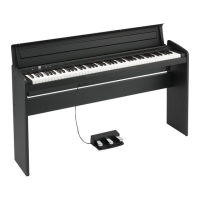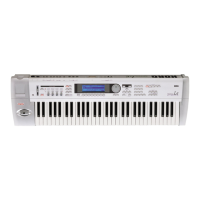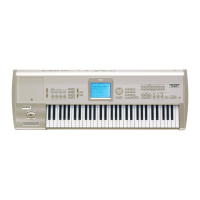About KARMA Overview
527
About KARMA
Overview
KARMA stands for Kay Algorithmic Realtime Music
Architecture, named after its inventor, Stephen Kay.
The KARMA function generates MIDI data, using many
different complex algorithms seamlessly integrated to
provide a powerful “music generation engine”. Based on the
notes and chords you play, KARMA generates phrases and
patterns in real-time, generating not just notes but MIDI
control data as well. The KARMA architecture allows the
various algorithms to be reconfigured and varied in
realtime, as you play them.
For example, you can create spectacular cascades of complex
interweaving notes, techno arpeggios and effects, dense
rhythmic and melodic textures, natural sounding glissandos
for acoustic instrument programs, guitar strumming and
finger-picking simulations, random effects, auto-
accompaniment effects, gliding and swooping portamento
and pitch bend effects, and new sound design possibilities.
KARMA lets you produce phrases and patterns far beyond
the level provided by conventional arpeggiators or pattern
playback functions.
Theory Of Operation
A performance of a musical phrase can be thought of as
having many different “attributes” which determine the
overall effect of the resulting music. For example, a musical
phrase has a “rhythm” attribute, which is the rhythm with
which the notes are being played. The number of notes
(“chords”) being played at the same time in various places
of the musical phrase could be called a “cluster” attribute.
The velocity (accent) with which the notes are played is a
“velocity” attribute. The spatial location in a stereo field
where the notes are played is a “pan” attribute, etc.
Typically, music that has been recorded or sequenced has all
of these attributes predetermined and fixed in relation to
each other. A specific note is to be played with a specific
rhythmic value for a specific period of time, at a specific
volume level, at a specific location in a stereo field, with the
sound of a specific musical instrument, and these
relationships remain fixed no matter how many times you
play back the performance. For example, in most if not all
auto-accompaniment instruments, to achieve a variation in
the accompaniment pattern the instrument essentially
switches to a different pre-recorded sequence of musical
events (again with specific relationships that are fixed in the
data).
In KARMA, every aspect of a musical phrase has been
separated into independently controllable attributes. Each of
these attributes is controlled by a separate group of
parameters, which can be individually varied or changed in
groups by the user in real-time as the music is being
generated; or changed all at once with the selection of a
program or combination.
KARMA can also be used to generate infinitely variable
randomized grooves and accompaniment backings. Up
until now there have been two basic types of backing track
generation. The traditional method used in all auto-
accompaniment keyboards is a system which analyzes notes
played on a keyboard (chord recognition) and then plays
back patterns stored in memory through transposition
tables. The second method is the one used by some
algorithmic software products that create new patterns each
time the algorithm is called. In general, the first method is
static and repetitive, while the second method cannot be
modified in real-time.
KARMA combines the algorithmic diversity of the second
method with the real-time control and immediate access of
the first method to create a new form of interactive groove
generation, where the user is in more direct control, since
what is produced is directly related to which notes are
pressed. Furthermore, extensive aspects of the rhythm,
velocity, chord size and other parameters can be randomly
varied in real-time to allow the user to control the
complexity and density of the resulting performance.
Whether you are playing programs or combinations,
performing with the KARMA Controls sliders, switches,
and drum/chord pads, giving a live performance, or
recording new music using the onboard sequencer, you can
take full advantage of the KARMA function at any time.

